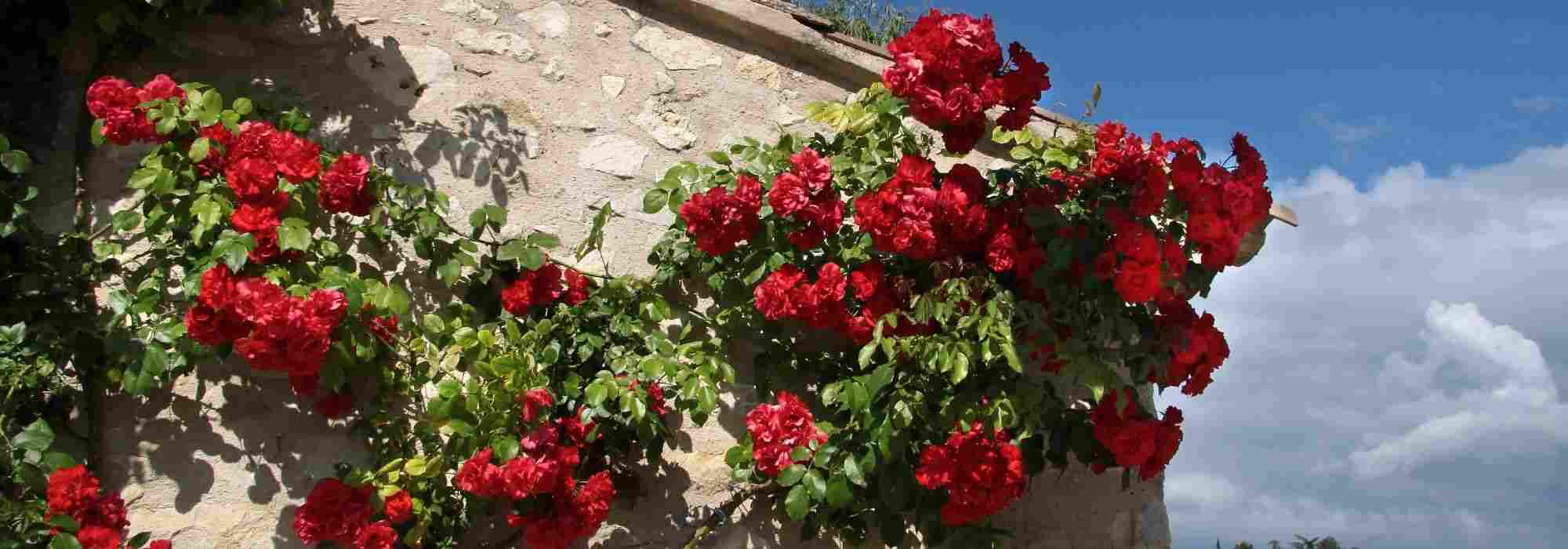
How to choose a climbing rose?
Buying guide and criteria to find the ideal climbing rose variety
Contents
Climbing roses are essential plants for romantic gardens. Their long, flexible stems climb various supports, allowing them to delicately adorn a gazebo, an archway, a pergola, a trellis against a wall, or even a tree.
Unlike liana roses, they are more modest in size (up to approximately 3.5 metres), less invasive and lighter. Some varieties can even be grown in pots or small gardens.
Finally, climbing roses require regular pruning to maintain a balanced shape and good health.
Generally hardy beyond -15°C, they can be adopted in most regions.
Follow our guide to find the climbing rose suited to your needs and desires. Based on various characteristics (flower colour and shape, fragrance, size, disease resistance,…), find the ideal climbing rose for your garden.

Based on the colour of the flowers
Climbing roses are, of course, available in classic colours such as white, pink, and red. However, if you desire more originality in the hues, other varieties offer blooms in more unusual colours.
Pink climbing roses
The classic and timeless pink-flowered roses are very much present among the climbing varieties.
Pink comes in all its shades, from the softest to the most vibrant:
- ‘Dentelle de Malines’ offers blooms ranging from pale pink to white;
- ‘Blossomtime’ flowers in a delicate porcelain pink;
- ‘Coral Dawn’ features pearly pink flowers;
- the very popular climbing rose ‘Pierre de Ronsard’ offers a fresh pink shaded with carmine;
- ‘Laguna’ presents a well-supported pink;
- ‘Aloha’ produces bright pink flowers with salmon highlights;
- the flowers of ‘Libertas’ lean towards magenta pink, enhanced by a sunny centre of yellow stamens;
- ‘Allegro’ graces us with a dark pink leaning towards cherry;
- ‘Crimson Shower’ prefers a dark pink leaning towards purple-violet;
- ‘Rosarium Uetersen’ nuances its pink with coral and silver highlights.
White climbing roses
Whether to adorn a very refined white garden or to highlight other colourful flowers, white climbing roses find their place everywhere. White indeed brings immediate lightness and brightness, whether isolated or in a bed, accompanied by other plants.
‘Alaska’ offers cream-white roses, while ‘Schneewalzer’ is adorned with very soft white flowers.
On their part, ‘Décorosiers Opalia Grimpant’ and ‘Trier’ offer blooms of pure white, contrasting with their yellow centre.
Red climbing roses
The red rose is the symbol of love and one of the most popular colours. It appears among climbing roses in various shades, sometimes very subtle:
- ‘Rambling Rosie’ leans towards a crimson red, highlighted by a small white heart;
- ‘Florentina’ is adorned with an intense red;
- ‘Le Grand Huit’ produces flowers of a dark red with a velvety appearance;
- ‘Red Eden Rose’ offers a purplish red with a satin effect;
- ‘Souvenir du Dr Jamain’ opts for a wine-red;
- the roses of ‘Sénégal’ are a red leaning towards black.
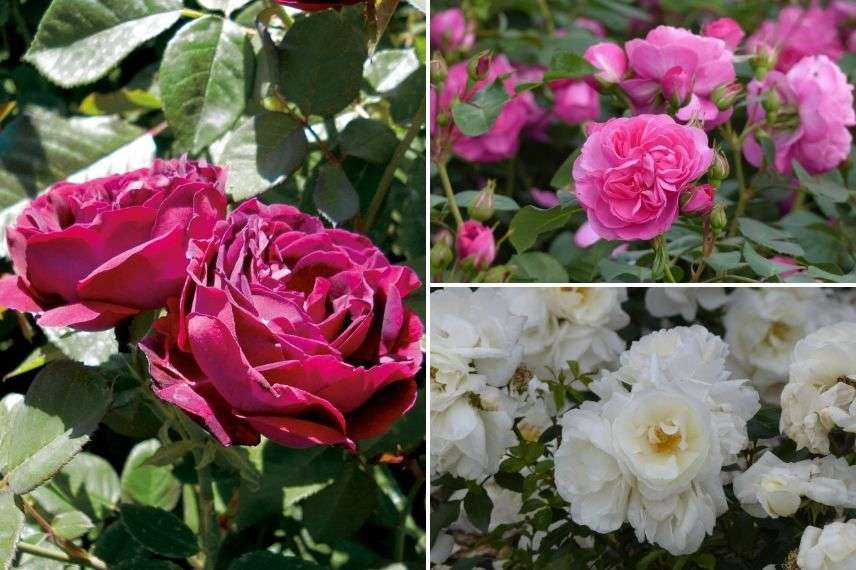
Rosa ‘Dr Jamain’, ‘Allegro’ and ‘Opalia’
Yellow and orange climbing roses
These yellow or orange roses immediately warm up the garden. A bit more delicate to associate, they will reveal all their charm in a beautiful colour scheme.
An association with complementary blue or violet plants will also bring a lot of vitality to the garden.
Opt for the apricot orange of ‘Orange Climber’ or the copper salmon orange of ‘Alibaba’.
‘Golden Boy’ likely offers the brightest yellow, while ‘Goldfassade’ opts for a yellow with a copper edge.
And if you can’t decide, the magnificent ‘Shining Beauty’ offers flowers of golden yellow mixed with orange.
→ Read also: Climbing roses with yellow and orange flowers to brighten up the garden!
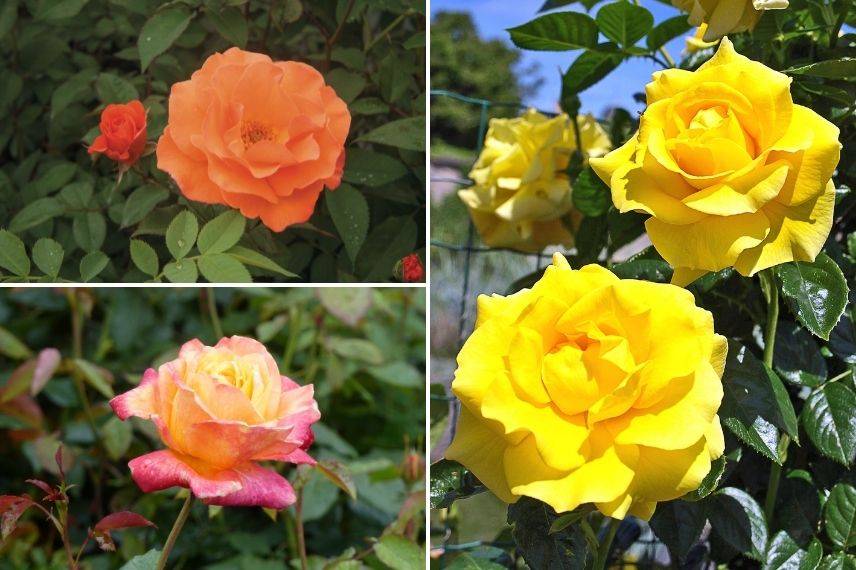 Rosa ‘Climber Orange’, ‘Shining Beauty’ and ‘Golden Boy’ on the right
Rosa ‘Climber Orange’, ‘Shining Beauty’ and ‘Golden Boy’ on the right
Bicolour or multicolour climbing roses
Multicoloured climbing roses bring an original and festive touch to the garden. Plant these varieties with variegated petals, as if splashed with paint, isolated to enjoy their beauty fully.
‘Hanabi’ offers flowers randomly splashed with pink and red on a white background, enhanced by a yellow centre. Very flashy, ‘Vihaïpi’ is dressed in red, yellow, and white.
More delicate, ‘Julie Andrieu’ offers us petals of white striped with pink, revealing a bright yellow centre.
‘Pirate’ dazzles with its blooms splashed with red-pink and white-pink.
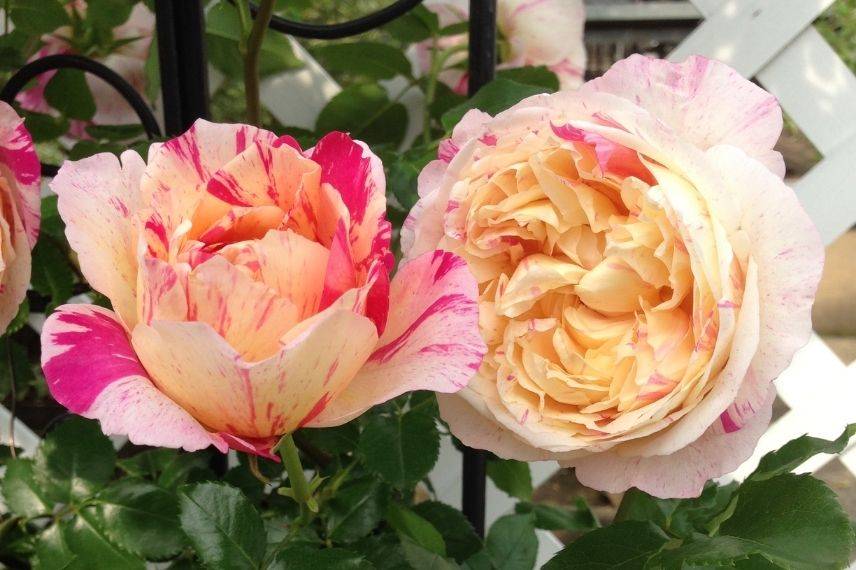 Rosa ‘Julie Andrieu’
Rosa ‘Julie Andrieu’
Based on the shape of the flowers
Climbing roses offer solitary flowers or small grouped bouquets. When it comes to their shape, choose between climbing roses with single, semi-double, or double flowers. For an even more spectacular flowering, opt for climbing roses with large flowers.
The vibrant climbing rose ‘Cocktail’ features simple eglantine flowers with 5 petals, revealing a contrasting heart of stamen full of zest, just like ‘Libertas’.
The climbing rose ‘Perennial Blue’ opts for semi-double eglantine flowers in a rare rose-lilac, offering several rows of petals.
The old rose ‘Ghislaine de Féligonde’ is adorned with true pom-poms of around thirty petals, in an exceptional evolving pastel colour. The English roses ‘David Austin’ also offer a multitude of petals.
For fans of old roses, the double cup flowers of ‘Florentina’ or those of the climbing rose ‘Cyclamen Pierre de Ronsard’ will delight you.
Among the most impressive flowers, we can mention ‘David Austin Bathsheba’, ‘Times Past’, and ‘That’s Jazz‘ with their flowers reaching 10 cm. ‘Le Grand Huit’ boasts roses of nearly 11 cm, while those of ‘Pierre de Ronsard’ can reach 12 cm, with the medal going to ‘Easy Fashion’ and its atypical bicolour flowers of 13 cm.

Rosa ‘Libertas’, ‘Ghislaine de Féligonde’, ‘Florentina’ and ‘Pierre de Ronsard’
Discover other Climbing Roses
View all →Available in 2 sizes
Available in 1 sizes
Available in 4 sizes
Available in 2 sizes
Available in 3 sizes
Available in 2 sizes
Available in 3 sizes
Available in 2 sizes
Based on the fragrance
Climbing roses generally have a fragrant flowering. Floral, spicy, or fruity notes, the scents are highly diverse.
Among the most fragrant varieties are:
- ‘Times Past’ with its pronounced citrus scent;
- ‘Zephirine Drouhin’, which exudes a powerful fruity fragrance reminiscent of raspberries or blackcurrants;
- ‘Papi Delbard’, revealing an old rose scent with notes of white fruits (apricot and peach) and citrus;
- ‘Nahéma’, whose name refers to the richest rose essence fragrance from Guerlain, offering a floral and fruity scent, enhanced by notes of lemongrass;
- ‘David Austin Bathsheba’ with its strong myrrh fragrance with honey notes, followed by tea rose;
- ‘David Austin Malvern Hills’, with a musky fragrance;
- ‘Blush Noisette’ with its more surprising clove scent, accentuated by sunny weather;
- ‘Sourire d’Orchidée’, whose flowers smell of apple and wild rose.
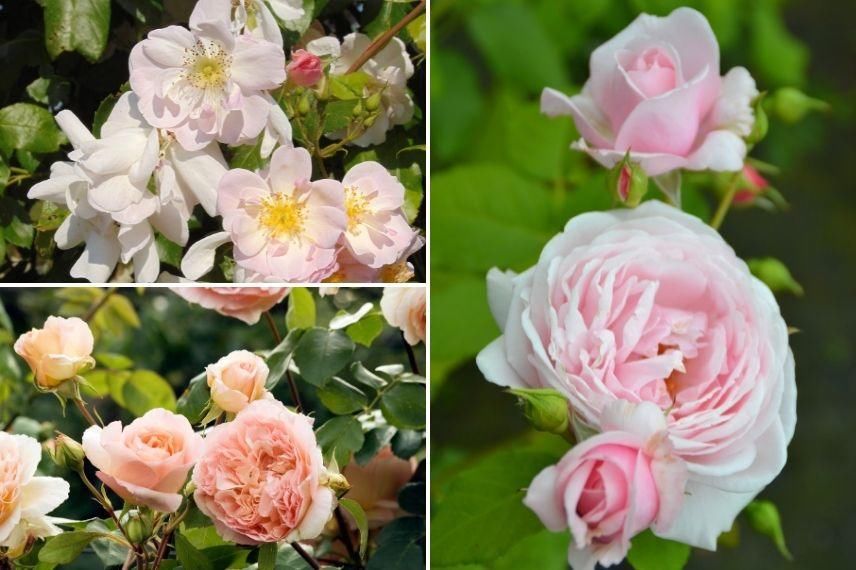
Rosa ‘Sourire d’Orchidée’, ‘Papi Delbard’ and ‘Nahéma’ on the right
According to the flowering period
Climbing roses often offer a very long flowering period, as most are perpetual. They can therefore bloom for several months almost continuously, from June to October.
Some cultivars have an early flowering period, starting as early as mid-spring in May. This is the case for the climbing rose ‘Clair Matin’, whose semi-double eglantine flowers appear early and enliven the garden until autumn.
Decoroses such as ‘Emera’ or ‘Opalia’ are also renowned for their long flowering from May to October.
For a flowering period that lasts late into the season, consider ‘Rosarium Uetersen’, a variety that withstands rain well, ideal for cool and humid climates. ‘Sourire d’Orchidée’, which is not demanding regarding climatic conditions, or the very hardy ‘Rose de Tolbiac’ also offer a good perpetual flowering until November.

Rosa ‘Rose de Tolbiac’ and to the right Rosa ‘Opalia’ and ‘Clair Matin’
The different sizes of climbing roses
Climbing roses generally reach at least 2 metres in height and can measure up to 3.5 metres at ripeness, or even 4 metres.
Unlike lianas, which are too imposing and vigorous, some climbing roses can indeed be grown in pots.
Perfectly suited for terraces, balconies, and small gardens, the climbing rose ‘Mini Eden Rose’ will thrive in a lovely container. Considered a large bush or a small climber, the old rose ‘Phyllis Bide’ will also adorn small spaces with its stunning, tousled flowering.
The Décorosiers ‘Opalia’ and ‘Emera’ can also acclimatise in large pots, thanks to their reduced spread (40 to 80 cm).
For dressing larger supports, turn to the bigger cultivars, such as the white climbing rose ‘Fée des neiges’, ‘Excelsa’ with its pompom red flowers, or ‘Gloire de Dijon’ with its unique shades.

Rosa ‘Phyllis Bide’ and ‘Excelsa’ (photos from Wikipedia)
The most disease-resistant climbing roses
Fungal diseases are very common in roses. To protect against these fungi, turn to less susceptible varieties, known for their resistance and naturally healthy foliage.
Roses that have received the selective and demanding ADR label are among these disease-resistant varieties, having passed tests in various climates without any treatment. These roses require almost no care and can withstand even difficult conditions (humidity, cold, etc.).
Among them are ‘Florentina’, ‘Jasmina’, ‘Laguna’, or the small ‘Perennial Blue’.
The range of Décorosiers has also received the prestigious award.
The cultivars from the German rose breeder Kordes are also renowned for their disease resistance, such as ‘Rosarium Uetersen’, ‘Amadeus’, or ‘Sympathie’.
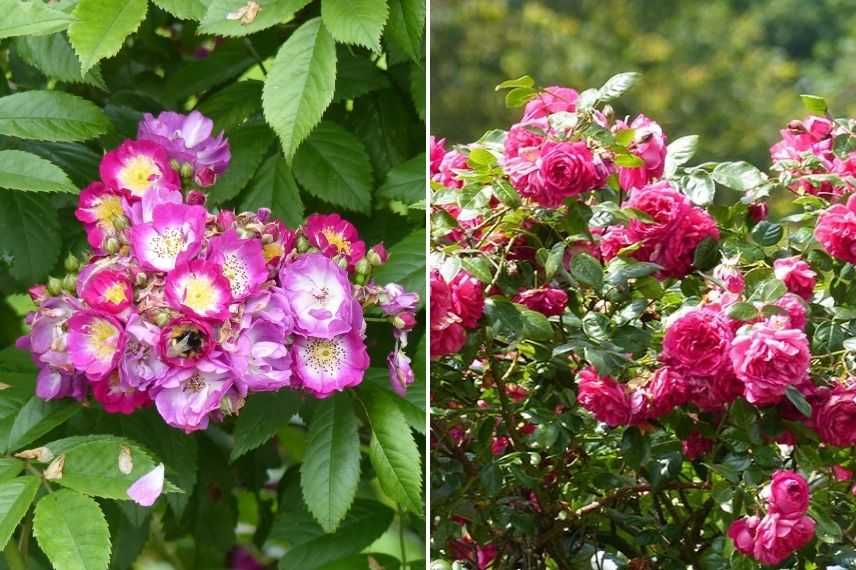
Rosa ‘Perennial Blue’ and ‘Laguna’
Semi-evergreen climbing roses
Generally deciduous, roses shed their leaves in autumn and lose their ornamental interest. While some varieties maintain aesthetic appeal with attractive decorative fruits, others may retain their leaves in mild winters.
This is the case with the ‘David Austin Malvern Hills’ rose with its elegant glossy leaves, ‘Alchymist’ with its leaves that start bronze and then turn dark green, as well as ‘Laguna’ with its vibrant shiny foliage.
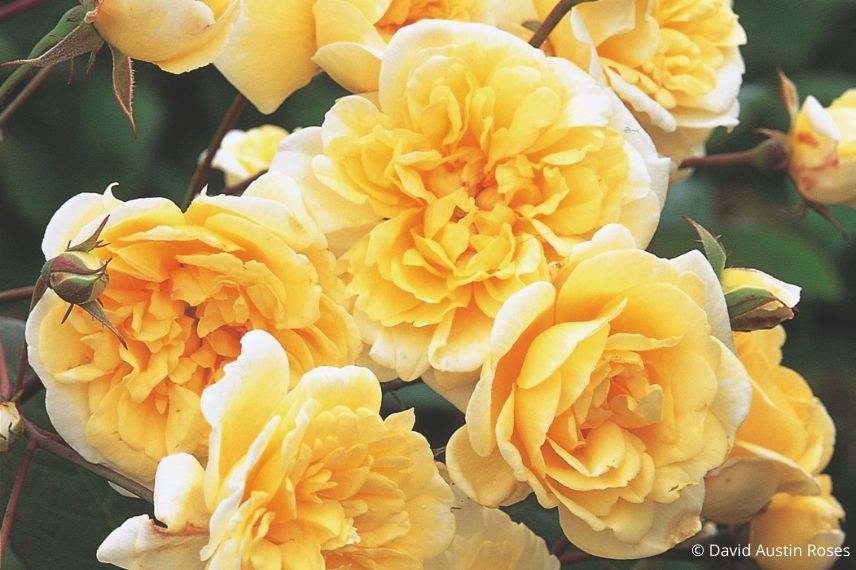
Rosa ‘David Austin Malvern Hills’
To go further
- Discover all our tips for successfully growing climbing roses in containers.
- Also, check out our article: “Which climbing rose to choose for container growing?“.
- Subscribe!
- Contents
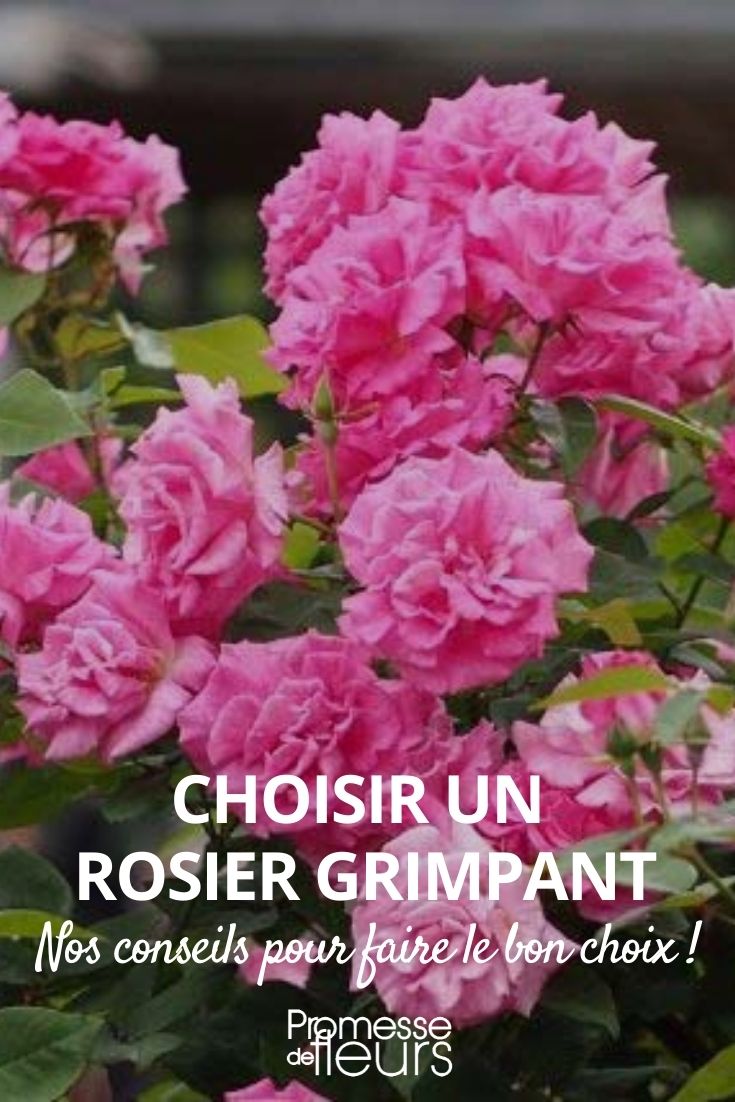
































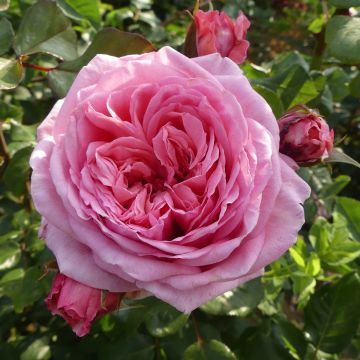
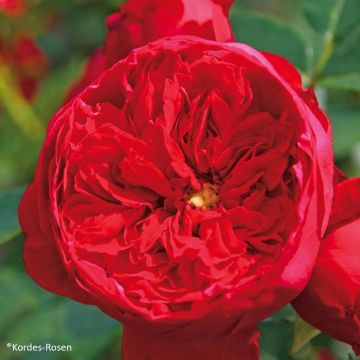
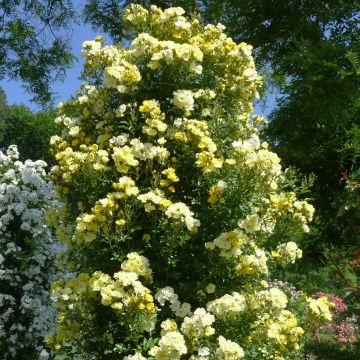
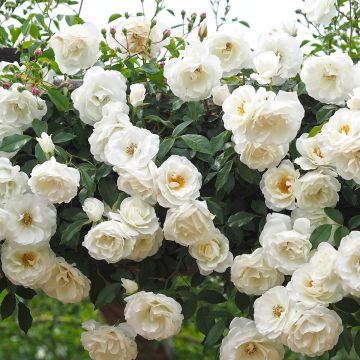
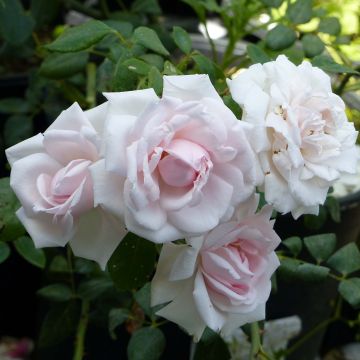
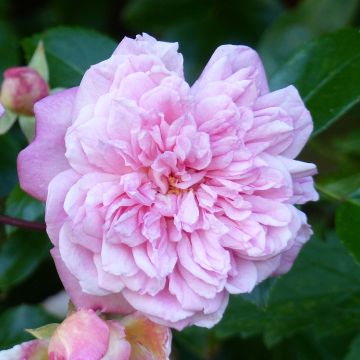
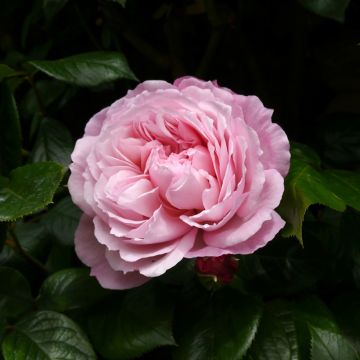
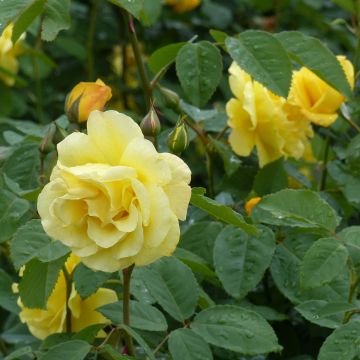
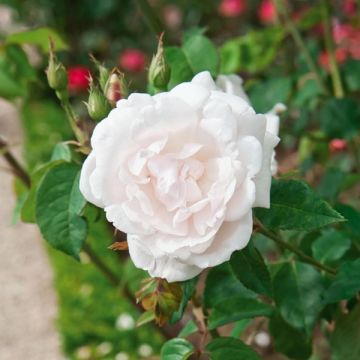
Comments